
 Key differences between the two main
"in goods" types (see image comparisons below):
Key differences between the two main
"in goods" types (see image comparisons below):
"Old" set often initially determined by poorer quality of these coins when cataloging the two types of "in goods".
| Denomination | Diameter (old set) (mm) |
Diameter (new set) (mm) |
Thickness (old set) (mm) |
Thickness (new set) (mm) |
Mass (old set) (grams) |
Mass (new set) (grams) |
| 3d | 19.8 | 19.8 | 1.25 | 1.5+ | 2.598 | 3.409+ |
| 6d | 24.3 | 24.9+ | 1.3 | 1.6+ | 4.310 | 5.429+ |
| 1/- | 29.1 | 29.25+ | 1.5+ | 1.45 | 7.264+ | 6.626 |
| 2/- | 32.6 | 33.0+ | 1.6 | 1.6 | 9.032 | 9.512+ |
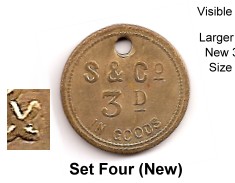 | 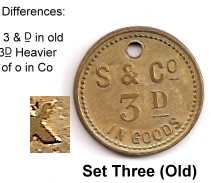 |
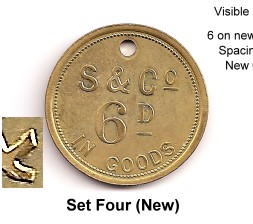 | 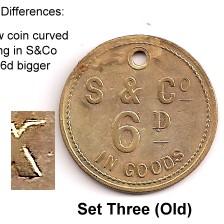 |
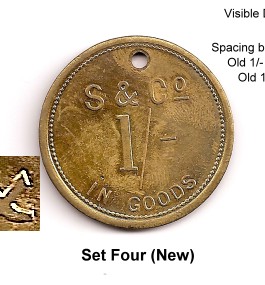 | 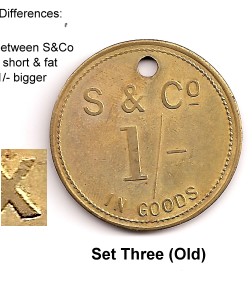 |
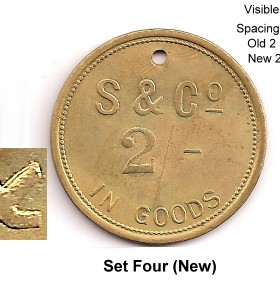 | 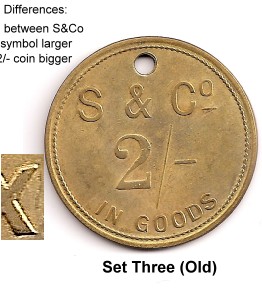
|
E J Maynard in the work "Tokens of Southern Africa
(A catalogue based on the collection in the Africana
Museum")* recognises only
three sets of the S&Co tokens with only one set of in goods. Dr Theron
in his book "Tokens of Southern Africa and
their history" also only recognises these three sets.
| The S&Co sets |
E J Maynard |
Maynard |
Dr Theron |
Theron |
Scott Balson's research |
Brian Hern |
Hern |
| S & Co | Type II |
C588-C591 |
Set I |
EG&T IX |
Set 1 | Set 1 | 582a/d |
| S & Co MH | Type III |
C592-C595 |
Set II |
EG&T IX |
Set 2 | Set 2 | 582e/h |
| Old S & Co "In Goods" | Type I | C584-C587 pg 108 |
Set III |
EG&T IX |
Set 3 | Set 3 | 582j/m |
| New S & Co "In Goods" | Type I |
C584-C587 |
Set III |
EG&T IX |
Set 4 | Set 4 | 582n/q |
However the fourth "set" of the S&Co is, as you can see above, clearly identifiable and a set in its own right, being a later mint of the "In Goods" set minted when demand for the tokens outstripped supply.
When one considers the generally accepted definition of "three" types of the Durban Club 6d as defined by minor changes such as milled or plain edges the argument for a fourth set of S&Co is well founded. On page 84 of Theron's book "Tokens of Southern Africa and their history" he refers to three sets of Durban Club tokens, all 6d. He uses Dr Mulock-Bentley and Pat Moran of Durban as his reference point saying, "There are three known varieties (of Durban Club token); two in a type of nickel and the other in white metal. The two varieties of nickel consist of 1 plain edge and 1 milled edge."
Consider then the inconsistency cementing Dr Theron's argument that the two "In Goods" sets are only part of one set - as transcribed from the scanned letter linked below. He says on pages one and two: "I think you are right in stating that you find differences in the "In Goods" sets, but as you remarked the one set appears old and the other almost uncirculated. One can therefore assume that a second batch of these tokens was made and that different dies were used. You will also find that the spacing of the S&Co is 1.5mm larger on the older variety." See Theron's letter at this link - page one; page two; page three, page four.
In the blow ups of the two in goods varieties above you will have seen that there are, in fact many other differences between the two sets of In Goods minted by Strachan and Co. Therefore, based on the Durban Club argument by highly respected experts in the field of token coins such as Mulock-Bentley, Moran and E J Maynard* (who also sites the three varieties of the Durban Club 6d based on the striking of different batches of the same coin) it is my contention that there are, in fact, two sets of "In Goods" token coins making up four identifiable Strachan and Co sets. It is clear that E J Maynard, when compiling the book "Tokens of Southern Africa. A Catalogue Based on the Collection in the Africana Museum"* for the Africana Library in Johannesburg, was not aware of the differences of two "In Goods" sets at the time of compiling this book in 1966. Her study was based on the limited number of tokens held by the Africana Museum and it is clear that until Balson counted the entire Strachan stock and noted the varieties no study of this depth on the tokens had been undertaken.
In the recent reference book on Southern African tokens by Brian Hern the author recognises the fourth set and clearly identifies the differences that set apart the two different sets of In Goods token coins produced by Strachan and Co.
NOTE: It was Allyn Jacobs who first discovered the defining common difference between the two "In Goods" sets - namely the fact that set three (the older set) has a straight tail on the ampersand (&) while the more recent set four has a curved tail. This is common to all four of the coins.
References:
"Kence the trade tokens of Strachan and
Co" by S Balson and C Graham (1978)
"Tokens of S Africa and their history"
by Dr G P Theron (1978)
"Tokens of Southern Africa. A Catalogue Based
on the Collection in the Africana Museum" by E J Maynard (1966)
*The Balson Holdings
Family Trust owns an original (royal blue covered) hard copy edition of E
J Maynard's book produced for the Africana Museum In Johannesburg. This First
Edition is entitled "Tokens of Southern Africa. A Catalogue Based on the
Collection in the Africana Museum". The copy is an extremely rare first edition
copy in excellent condition with original binding of blue cloth with gilt
edges.
"Hern's Handbook on Southern African
tokens" by Brian Hern with research support by Allyn Jacobs (2004)
:
